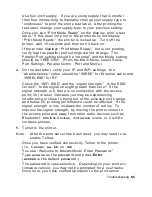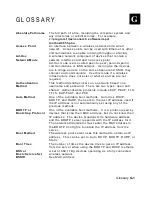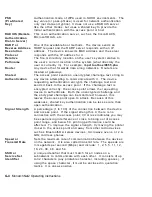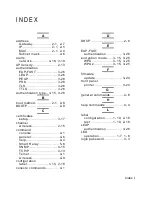
G-6
MonarchNet2 Operating Instructions
WEP or
Wired
Equivalent
Privacy
A security protocol for wireless local area networks. WEP was
designed to provide the same level of security as that of a
wired network, which is inherently more secure than a wireless
network because wired networks are easily protected against
unauthorized access. Wireless networks use radio waves to
communicate and can be vulnerable to unauthorized users.
WEP provides security by encrypting data over radio waves so
that it is protected as it is transmitted. However, it has been
found that WEP is not as secure as once believed.
Note:
If one part of a wireless network has WEP enabled, they
all must have it enabled with the same key or they cannot
communicate.
128 Bit / 64 Bit
WEP Key
This is the 64 or 128 bit WEP key that must match other
Nodes’ encryption keys in order to communicate: 10 hex
characters for 64 bit (40 user-specified characters), or 26 hex
characters for 128 bit (104 user-specified characters). You
must use the same key values for devices to communicate with
each other.
WLAN or
Wireless Local
Area Netw ork
A LAN that uses high-frequency radio waves to communicate
between nodes, rather than telephone wires, etc.
WPA (Wi-Fi
Protected
Access)
A network security protocol that uses improved authentication
and temporal keys. It was created to address the weaknesses
of WEP encryption.
WPA2
(or IEEE 802.11i)
A network security protocol with stronger encryption than WPA.
It was created to address the weaknesses of WEP encryption.
Summary of Contents for Monarch 9860
Page 6: ...iv ...
Page 16: ...1 10 MonarchNet2 Operating Instructions ...
Page 34: ...2 18 MonarchNet2 Operating Instructions ...
Page 84: ...4 24 MonarchNet2 Operating Instructions ...
Page 100: ...6 8 MonarchNet2 Operating Instructions ...
Page 112: ...iv MonarchNet2 Operating Instructions ...
Page 113: ......
Page 114: ......







































